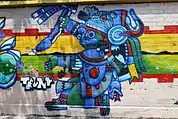List of rain deities
There are many different gods of rain in different religions:

Aztec god Tlaloc, Millan Primary School in Mexico City
African
African mythology
- Anẓar, god of rain in Berber mythology.
- Achek, wife of the rain god Deng in Dinka mythology
- Mangwe, a water spirit known as "the flooder" in the beliefs of the Ila people of Zambia[1]
- Oya, goddess of violent rainstorms in Yoruba mythology
- Sinvula, god of rain in Bantu mythology
- Nanvula/Nomvula goddess of rain Bantu mythology
- Mbaba Mwana Waresa, goddess of rain in Bantu mythology
- Mpulu Bunzi, god of rain in Kongo mythology.
- Bunzi, goddess of rain in Woyo mythology (Kongo).
American
Mesoamerica
- Chaac, in Maya religion;
- Tohil, in K'iche' Maya mythology
- Q'uq'umatz, another K'iche' Maya rain god
- Tlaloc, in Aztec and all the other Nahua religions;[2]
- Cocijo, in Zapotec religion;[3]
- Tirípeme Curicaueri, in Purépecha religion;
- Dzahui, in Mixtec religion;[4]
- Mu'ye, in Otomi religion
- Jaguar, in Olmec religion
- Quiateot of the Nicarao people in Nicaragua
North America
- Yuttoere, in De'ne' and Carrier
- Asiaq, goddess among Greenlandic Inuit,[5] and Inuit in Northern Canada
- Shotokunungwa of Hopi people
- Tó Neinilii of Navajo people
- Coyote (Navajo mythology)
South America
- Eschetewuarha of Chamacoco
- Chibchacum in the religion of the Muisca
Asian
Filipino mythologies
- Oden (Bugkalot mythology): deity of the rain, worshiped for its life-giving waters[6]
- Apo Tudo (Ilocano mythology): the deity of the rain[7]
- Anitun Tauo (Sambal mythology): the goddess of win and rain who was reduced in rank by Malayari for her conceit[8]
- Anitun Tabu (Tagalog mythology): goddess of wind and rain and daughter of Idianale and Dumangan[9]
- Bulan-hari (Tagalog mythology): one of the deities sent by Bathala to aid the people of Pinak; can command rain to fall; married to Bitu-in[10]
- Santonilyo (Bisaya mythology): a deity who brings rain when its image is immersed at sea[11]
- Diwata Kat Sidpan (Tagbanwa mythology): a deity who lives in the western region called Sidpan;[12] controls the rains[13]
- Diwata Kat Libatan (Tagbanwa mythology): a deity who lives in the eastern region called Babatan;[14] controls the rain[15]
- Diwata na Magbabaya (Bukidnon mythology): simply referred as Magbabaya; the good supreme deity and supreme planner who looks like a man; created the earth and the first eight elements, namely bronze, gold, coins, rock, clouds, rain, iron, and water; using the elements, he also created the sea, sky, moon, and stars; also known as the pure god who wills all things; one of three deities living in the realm called Banting[16]
- Tagbanua (Manobo mythology): the god of rain[17]
- Pamulak Manobo (Bagobo mythology): supreme deity and creator of the world, including the land, sea, and the first humans; throws water from the sky, causing rain, while his spit are the showers;[18] controls good harvest, rain, wind, life, and death; in some myths, the chief deity is simply referred as the male deity, Diwata[19]
Hindu mythology
- Indra
- Mariamman
- Parjanya
- Shakambhari
- Surupa, sky goddess who brings rain
- Varuna
- Varshini, goddess who brings gentle rain from heaven.
Tibetan mythology
- Kalden
- Lumo, sky goddess of rain and mist
European
Lithuanian mythology
- Blizgulis, god of snow
Norse Mythology
- Freyr, Norse god of rain, sunshine, summer and fertility
Slavic mythology
- Dodola, goddess of rain
- Dudumitsa, Bulgarian goddess of rain
Notes
- McVeigh, Malcolm J. (1974). God in Africa: Conceptions of God in African Traditional Religion and Christianity. C. Stark. p. 14. ISBN 9780890070031.
- Noticia del Dia (in Spanish)
- Miller & Taube 1993, 2003, p.64.
- Terraciano, Kevin (2001). The Mixtecs of colonial Oaxaca: Ñudzahui history, sixteenth through eighteenth centuries. Stanford, CA: Stanford University Press. ISBN 0-8047-3756-8. OCLC 45861953.
- Monaghan, Patricia (2009). Encyclopedia of Goddesses and Heroines [2 volumes]. ABC-CLIO. p. 139. ISBN 978-0-313-34990-4.
- Wilson, L. L. (1947). Ilongot Life and Legends. Southeast Asia Institute.
- Llamzon, Teodoro A. 1978. Handbook of Philippine language groups. Quezon City, Philippines: Ateneo de Manila University Press.
- Jocano, F. L. (1969). Philippine Mythology. Quezon City: Capitol Publishing House Inc.
- Jocano, F. L. (1969). Philippine Mythology. Quezon City: Capitol Publishing House Inc.
- Eugenio, D. L. (2013). Philippine Folk Literature: The Legends. Quezon City: University of the Philippines Press
- San Agustín, G. (1998). Conquistas de las Islas Filipinas, 1565–1615 (Spanish Edition): Bilingual ed edition. San Agustin Museum.
- Filipino Heritage: The metal age in the Philippines (1977). Manila: Lahing Pilipino Pub.
- Fox, R. B. (1982). Religion and Society Among the Tagbanuas of Palawan Island, Philippines. Manila: National Museum.
- Filipino Heritage: The metal age in the Philippines (1977). Manila: Lahing Pilipino Pub.
- Fox, R. B. (1982). Religion and Society Among the Tagbanuas of Palawan Island, Philippines. Manila: National Museum.
- Unabia, C. C. (1986). THe Bukidnon Batbatonon and Pamuhay: A Socio-Literary Study. Quezon City : UP Press.
- Jocano, F. L. (1969). Philippine Mythology. Quezon City: Capitol Publishing House Inc.
- Benedict, L. W. (1913). Bagobo Myths. Journal of American Folklore, pp. 26 (99): 13–63.
- Jocano, F. L. (1969). Philippine Mythology. Quezon City: Capitol Publishing House Inc.
- Thompson, Hunter (1979). The Great Shark Hunt: Strange Tales from a Strange Time, 1st ed., Summit Books, 105-109. ISBN 0-671-40046-0.
This article is issued from Wikipedia. The text is licensed under Creative Commons - Attribution - Sharealike. Additional terms may apply for the media files.